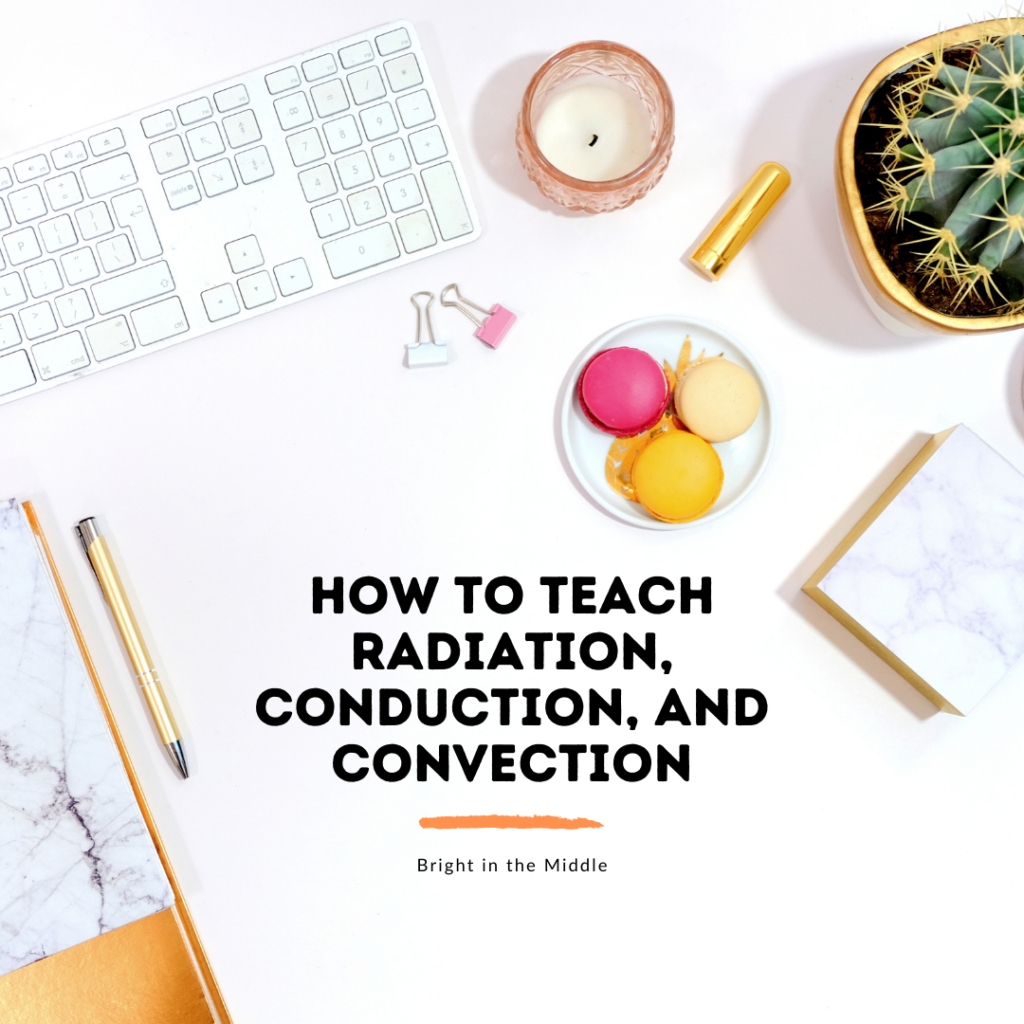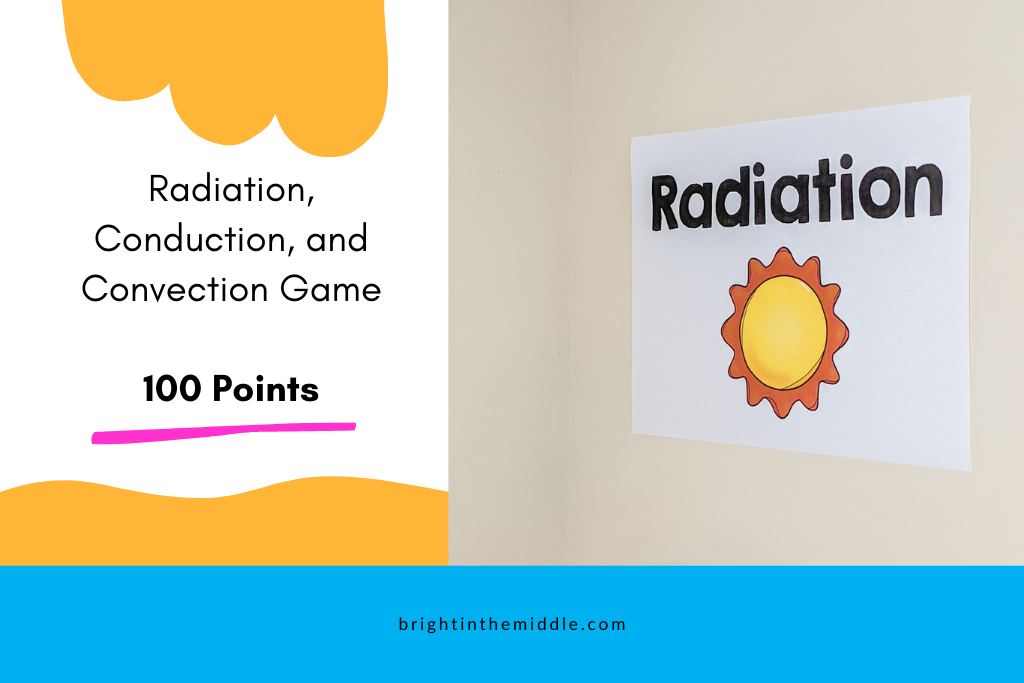The topic of radiation, conduction, and convection is one of my favorites. Like many topics in science, when you learn about these methods, you are learning pieces of how our world works.
Not only is it an awesome topic to learn about, but it’s an awesome topic to teach about! There are so many cool things that you can do in the classroom, besides just lecturing and moving forward. This topic is just a piece of the energy transfer puzzle. Let’s learn more by starting with radiation, conduction, and convection definitions!
You can really bring the WOW Factor with this topic!
What is radiation, conduction, and convection?
Radiation, conduction, and convection are the three main methods of heat transfer. Well, what exactly is heat? It’s the form of energy (thermal) that is transferred from objects that are different temperatures. So, what is the difference between radiation, conduction, and convection?
- Radiation is the transfer of energy by electromagnetic waves. Radiation does not require matter for heat to transfer through.
- Conduction is heat transfer by direct contact and is associated with mostly solids.
- Convection transfers heat by currents within a fluid or gas. Heat moves in a circular pattern where the warm rises and the cold sinks.
Now that we are able to define these terms, it’s time to go over some examples.

Radiation, Conduction, and Convection Examples
- Since radiation is the transfer of energy by electromagnetic waves, some examples include heat transfer from, mostly famously, the sun, a bonfire, heat lamps, microwaves, hair dryers, radiators, and the emission of gamma rays.
- Remember that conduction is the transfer of heat by direct contact. Touching anything hot (or cold) will transfer heat. Some examples include a piece of cheese melting on a cheeseburger, touching a hot kettle, a metal spoon getting hot after sitting in hot chocolate, sitting on a hot slide, and cooking pancakes on a skillet.
- Convection is transfer by currents where warm rises and cold sinks. Some examples of convection include the air moving in your home, the water in the swimming pool being warmer at the top and cooler at the bottom, a pot of water heating, and sea breezes and land breezes in the atmosphere.
Can you describe examples of radiation conduction and convection from your daily life? There are so many more! Think of some of your own that you can share with your students. You can create a diagram of radiation, conduction, and convection examples to share as an anchor chart on the classroom wall.
Now that I’ve shared a bit of background information that will help you to teach these 3 types of heat transfer, I want to talk about 3 easy and creative ways to relay this information to your students.

Radiation, Conduction, and Convection Game – 100 points
This is an awesome activity if you want to get students thinking critically and to get out of their seats and up and moving!
This is just one of the conduction, convection, and radiation games that you can put in your teacher toolbox. So, I know you are dying to know…what is 100 points?!
Game Directions:
- Have your students to get out a piece of paper and write radiation, conduction, and convection down. Students will be looking at which one they feel is the most important to the least important.
- Tell your students to, individually, assign points to these three types of heat transfer, giving the most points to the one that they feel is the most important. They have 100 points to give! For example, a student may assign 60 points to radiation, 30 points to convection, and 10 points to conduction. Another student may feel that convection is the most important. The second student may assign 50 points to convection, 25 points to conduction, and 25 points to radiation. There are so many combinations that your students may choose.
- Before students do this step, you, as the teacher, should have 3 signs in 3 of the corners of the room, one saying radiation, one saying conduction, and the other saying convection. After students have individually assigned their points. They will go to the corner of the room (where the sign is located) to the type of heat transfer that they gave the most points to.
- Once all of the students have gone to the corner of their most important method of heat transfer, they will find a partner to discuss why they chose it as the most essential.
- After this, you can have them move to the corner of their 2nd and 3rd choice and repeat the partner talk.
- If students decide that all are equally important, they can just choose their favorite and go to that corner!

Heat Transfer: Radiation, Conduction, and Convection Digital Interactive Lesson
Digital Interactive Lessons are a great tool to use with any topic in middle school science, and the heat transfer digital interactive lesson is no exception.
This lesson can be used as your initial lesson, direct instruction, small groups, partner activities, science centers, for distance learning, for enrichment, “I’m finished” stations, and SO MUCH MORE!
This particular digital interactive lesson is packed full of goodies to help your students dive deeper in understanding the 3 types of heat transfer and even answers the question, “how do radiation, conduction, and convection affect the atmosphere?”.
This lesson is compatible with Google Slides™ and PowerPoint and includes activities within that allows student to answer questions, drag and drop fun, a radiation, conduction, and convection sort, highlight examples of heat transfer in a story, and writing a story! So much fun!
There is a paper and digital version available for this resource. There are many options to best fit the need of your classroom.
What are others saying about this?
“This was a great review assignment for my students! I really like how the slides have pictures and questions sprinkled throughout. This is my second time buying this type of resource from this creator!” – TPT Reviewer, 7th Grade
“Thank you. It was so nice to have something that allowed the scholars to be interactive in this time of learning instead of me just doing a lecture. IT was great.” – TPT Reviewer, 7th and 8th Grade
My favorite thing about digital interactive lessons is that they are fun, engaging, and NO PREP!
You can also find this in the ENERGY UNIT!
Hot Chocolate Heat Transfer Story
This activity is SO much fun, especially if you are teaching in the winter months. This gives your students a chance to show their creative side, while enjoying a cup of hot chocolate.
This is a great interdisciplinary activity as well because you are able to incorporate the ELA standards for your state if you wish. So, what exactly will the students be doing? They will create a story about hot chocolate, including examples of radiation, conduction, and convection. You can set the guidelines however you like. Will there be a certain number of words? Will they follow a particular structure? Are they going to be writing freely? It’s totally up to you!

What else is up to you? When they have their cup of hot chocolate: before, during, or after they write their story.
One of the easiest ways to prepare hot chocolate for a lot of students is to make a crockpot recipe. There are tons on Pinterest! Here is one that I’ve tried before that is pretty tasty!
This would also be a great time to discuss conductors and insulators too! These foam cups will work great as a insulator (and for the topic too!).
[Disclaimer: This post contains Amazon affiliate links. If you make a purchase through these links, I may earn a small commission at no extra cost to you.]
Bonus: Thermal Energy Transfer Models
How does heat transfer? What if your students were to look at a model of different ways that heat transfers?
For example, would they know looking at a diagram? What about an experiment? What about an analogy?
What in the world am I talking about? So, in this engaging activity, students can look a six models, such as the one’s listed about, and identify the type of heat transfer and explain how it illustrates the transfer of each through a material.
It’s such a unique activity, students will love working on their critical thinking skills!
You can find this resource in the Bright in the Middle Shop.
You can also find this on TPT.
More Resources on Teaching Thermal Energy Transfer in the Middle School Classroom
Want to learn more about these 3 types of heat transfer and ideas for teaching in the classroom? Check these resources out.
Conduction Convection and Radiation Activities
Simple Radiation and Conduction Experiment
I hoe you have enjoyed these radiation conduction and convection ideas!



[…] Radiation, Conduction, and Convection […]